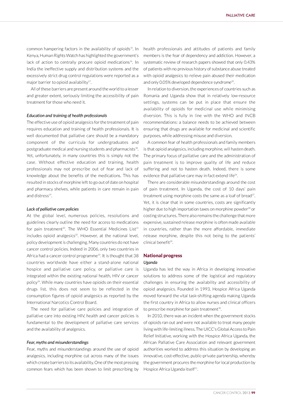
PALLIATIVE CARE
common hampering factors in the availability of opioids15. In health professionals and attitudes of patients and family
Kenya, Human Rights Watch has highlighted the government’s members is the fear of dependency and addiction. However, a
16
lack of action to centrally procure opioid medications . In systematic review of research papers showed that only 0.43%
India the ineffective supply and distribution systems and the of patients with no previous history of substance abuse treated
excessively strict drug control regulations were reported as a with opioid analgesics to relieve pain abused their medication
major barrier to opioid availability17. and only 0.05% developed dependence syndrome25.
All of these barriers are present around the world to a lesser In relation to diversion, the experiences of countries such as
and greater extent, seriously limiting the accessibility of pain Romania and Uganda show that in relatively low-resource
treatment for those who need it. settings, systems can be put in place that ensure the
availability of opioids for medicinal use while minimising
Education and training of health professionals diversion. This is fully in line with the WHO and INCB
The effective use of opioid analgesics for the treatment of pain recommendations: a balance needs to be achieved between
requires education and training of health professionals. It is ensuring that drugs are available for medicinal and scientific
well documented that palliative care should be a mandatory purposes, while addressing misuse and diversion.
component of the curricula for undergraduates and A common fear of health professionals and family members
postgraduate medical and nursing students and pharmacists18. is that opioid analgesics, including morphine, will hasten death.
Yet, unfortunately, in many countries this is simply not the The primary focus of palliative care and the administration of
case. Without effective education and training, health pain treatment is to improve quality of life and reduce
professionals may not prescribe out of fear and lack of suffering and not to hasten death. Indeed, there is some
knowledge about the benefits of the medications. This has evidence that palliative care may in fact extend life26.
resulted in stocks of morphine left to go out of date on hospital There are considerable misunderstandings around the cost
and pharmacy shelves, while patients in care remain in pain of pain treatment. In Uganda, the cost of 10 days’ pain
and distress19. treatment using morphine costs the same as a loaf of bread27.
Yet, it is clear that in some countries, costs are significantly
Lack of palliative care policies higher due to high importation taxes on morphine powder28 or
At the global level, numerous policies, resolutions and costing structures. There also remains the challenge that more
guidelines clearly outline the need for access to medications expensive, sustained release morphine is often made available
for pain treatment20. The WHO Essential Medicines List21 in countries, rather than the more affordable, immediate
22
includes opioid analgesics . However, at the national level, release morphine, despite this not being to the patients’
policy development is challenging. Many countries do not have clinical benefit29.
cancer control policies. Indeed in 2006, only two countries in
Africa had a cancer control programme23. It is thought that 38 National progress
countries worldwide have either a stand-alone national Uganda
hospice and palliative care policy, or palliative care is Uganda has led the way in Africa in developing innovative
integrated within the existing national health, HIV or cancer solutions to address some of the logistical and regulatory
policy24. While many countries have opioids on their essential challenges in ensuring the availability and accessibility of
drugs list, this does not seem to be reflected in the opioid analgesics. Founded in 1993, Hospice Africa Uganda
consumption figures of opioid analgesics as reported by the moved forward the vital task-shifting agenda making Uganda
International Narcotics Control Board. the first country in Africa to allow nurses and clinical officers
The need for palliative care policies and integration of to prescribe morphine for pain treatment30.
palliative care into existing HIV, health and cancer policies is In 2010, there was an incident when the government stocks
fundamental to the development of palliative care services of opioids ran out and were not available to treat many people
and the availability of analgesics. living with life-limiting illness. The UICC’s Global Access to Pain
Relief Initiative, working with the Hospice Africa Uganda, the
Fear, myths and misunderstandings African Palliative Care Association and relevant government
Fear, myths and misunderstandings around the use of opioid authorities worked to address this situation by developing an
analgesics, including morphine cut across many of the issues innovative, cost-effective, public-private partnership, whereby
which create barriers to its availability. One of the most pressing the government procures the morphine for local production by
common fears which has been shown to limit prescribing by Hospice Africa Uganda itself31.
CANCER CONTROL 2013 99